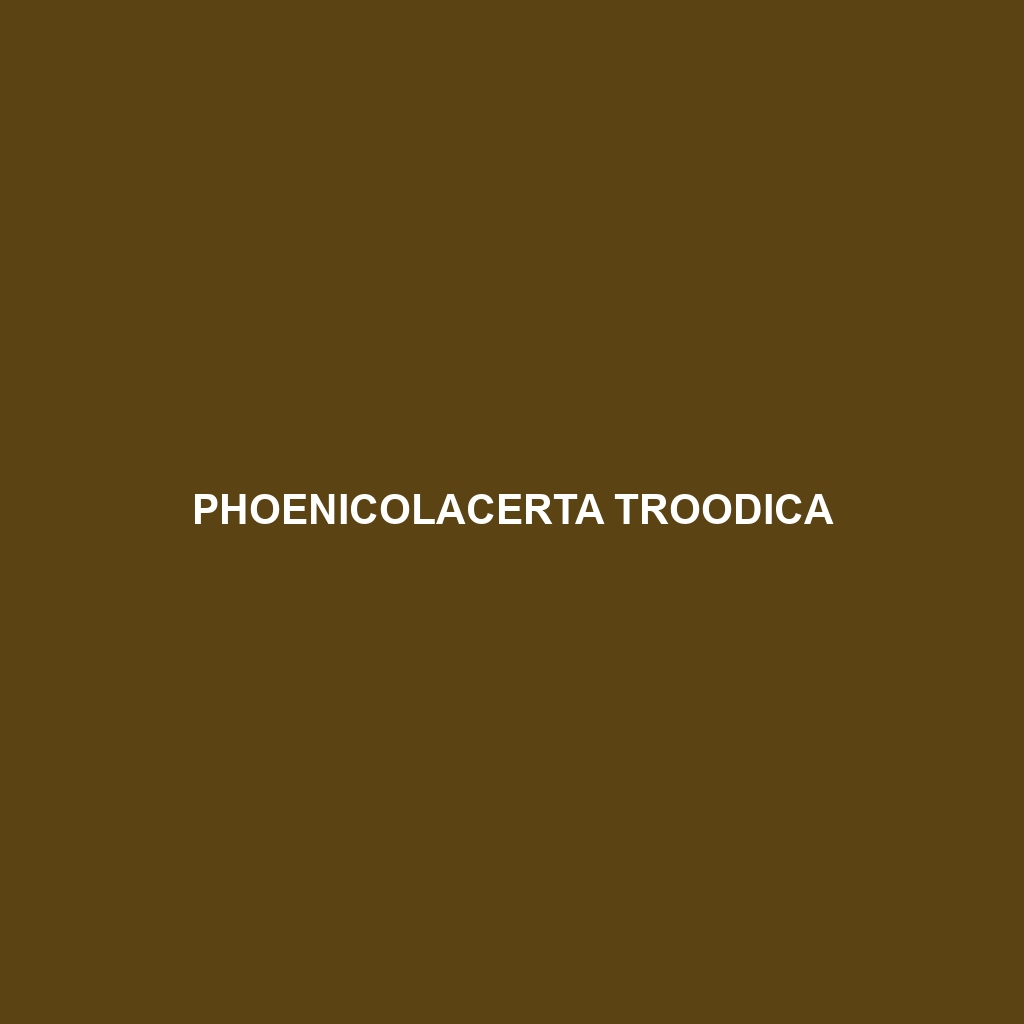Common Name
Phoenicolacerta troodica
Scientific Name
Phoenicolacerta troodica
Habitat
Phoenicolacerta troodica, commonly known as the Troodos lizard, is primarily found in the mountainous regions of Cyprus, specifically around the Troodos mountain range. These lizards thrive in diverse habitats, predominantly in temperate forests and montane ecosystems that feature a mix of evergreen trees, dense undergrowth, and rocky outcrops. The climate in this region is characterized by warm summers and mild winters, offering a suitable environment for this species. In addition to forests, these lizards can occasionally be spotted in nearby meadows and scrublands, showcasing their adaptability to various environmental conditions. Their preference for specific microhabitats often leads them to areas with ample cover, including leaf litter and stones, which provide protection from predators and harsh weather.
Physical Characteristics
Phoenicolacerta troodica exhibits distinctive physical traits that set it apart from other lizard species. Typically, adults reach a length of about 15 to 20 centimeters. Their bodies are elongated, with a stout build, enabling them to navigate through dense underbrush effortlessly. The coloration of Phoenicolacerta troodica varies depending on the habitat but often includes shades of olive green, brown, or gray, which act as camouflage against the forest floor. Unique features include a prominent crest along the back and small, granular scales that provide an interesting texture. Notably, during the mating season, males display vibrant hues, particularly in the throat area, to attract females, making them easier to identify during courtship rituals.
Behavior
The behavior of Phoenicolacerta troodica is marked by a variety of fascinating traits. These lizards are primarily diurnal, exhibiting activity during daylight hours. They are known to be territorial, especially males, who engage in displays of dominance to ward off other competitors. Social interactions include elaborate courtship rituals where males perform visual displays by bobbing their heads and flashing their colorful throats. Unlike many lizard species, Phoenicolacerta troodica exhibits minimal migratory behavior, instead opting to stay within defined territories throughout their lifecycle. During the hotter months, they tend to seek shelter under rocks or in burrows to avoid excessive heat, showcasing their adaptability to changing environmental conditions.
Diet
Phoenicolacerta troodica is primarily an insectivore, feeding on a variety of invertebrates available in its habitat. Their diet consists mainly of ants, spiders, and a range of small insects, which provide essential nutrients for growth and reproduction. Occasionally, they may consume plant matter, making them somewhat omnivorous. The hunting technique of Phoenicolacerta troodica is characterized by quick, darting movements that help them capture prey effectively. This feeding behavior not only highlights their role as predators in their ecosystem but also underscores the balance they help maintain within their habitat’s food web.
Reproduction
The reproductive cycle of Phoenicolacerta troodica begins in early spring when mating season occurs. Males attract females through their vibrant displays and courtship behaviors. After successful mating, females will lay a clutch of approximately 4 to 10 eggs during the summer months. The gestation period varies but generally lasts between 6 to 8 weeks. The eggs are often deposited in sandy soil or under loose debris to ensure the proper conditions for incubation. Hatchlings emerge in late summer or early fall, being fully independent from birth, showcasing the lizard’s adaptation to survive in a competitive environment. Parental investment is minimal, as adults do not exhibit any protective behaviors towards the hatchlings.
Conservation Status
According to the International Union for Conservation of Nature (IUCN), Phoenicolacerta troodica is currently classified as a species of ‘Least Concern.’ However, its populations are threatened by habitat destruction due to urbanization and agricultural expansion. Conservation efforts are vital to protect their habitats from ongoing environmental changes and human activities. Local initiatives to preserve areas of the Troodos mountains are underway, emphasizing the importance of maintaining biodiversity and ecological integrity to ensure the species’ survival.
Interesting Facts
One peculiar fact about Phoenicolacerta troodica is its ability to withstand considerable temperature variations. These lizards have adapted to escape the intense sunlight by becoming more active during cooler parts of the day. Moreover, their unique mating displays not only attract potential partners but also serve to signal threats to rivals, showcasing their dual-function communication methods. Furthermore, they are often seen basking on rocks, which helps them regulate their body temperature, reinforcing their behavioral adaptations to their mountainous habitat.
Role in Ecosystem
Phoenicolacerta troodica plays a crucial role in its ecosystem as both a predator and prey. As an insectivore, it helps regulate insect populations, thus maintaining balance within its food web. Additionally, their presence provides a food source for larger predators, including birds and mammals. These interactions highlight their importance in the ecological dynamics of the Troodos region. By contributing to the control of pest species and serving as prey, Phoenicolacerta troodica is integral to the overall health and functionality of its habitat.
